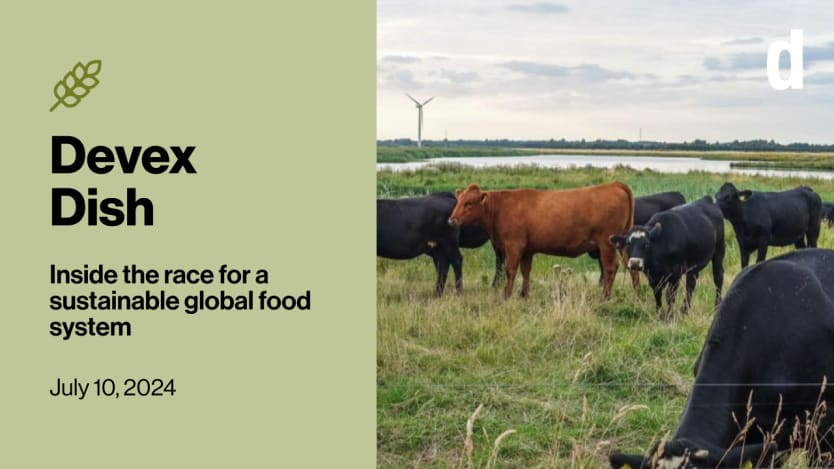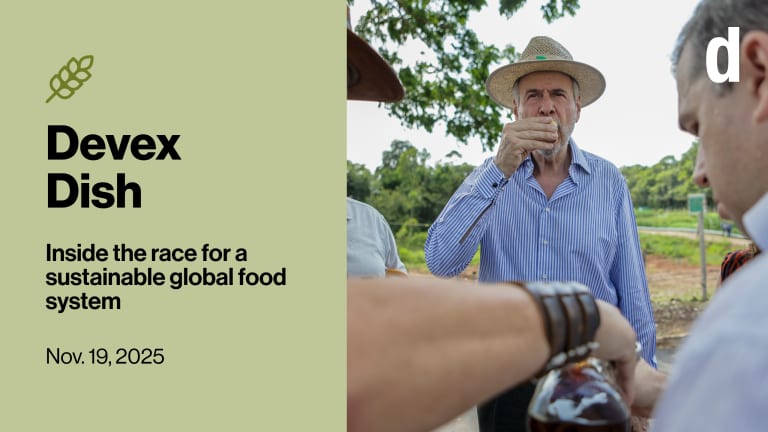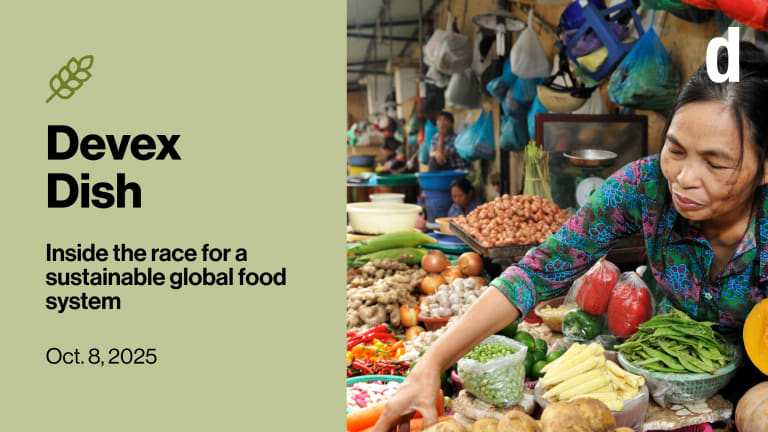Presented by Heifer International

Denmark is on its way to becoming the first country in the world to tax greenhouse gas emissions from agriculture.
Last month, its government announced a plan to charge farmers for emissions from their livestock starting in 2030. Farmers would face a headline tax of 300 Danish krone (about $43) per ton of carbon dioxide equivalent emissions, which would rise to 750 Danish krone by 2035. The scheme will be phased in with a basic tax deduction of 60% for at least the first two years.
It’s all aimed at fulfilling Denmark’s target of cutting its greenhouse gas emissions by 70% from 1990 levels — and the centrist government pulled it off by striking a historic deal with farming and environmental groups. The Nordic nation of nearly 6 million people is a major pork and dairy producer, with agriculture and forestry set to account for nearly half of its emissions by the end of the decade.
This is a preview of Devex Dish
Sign up to this weekly newsletter to get the inside track on how agriculture, nutrition, sustainability, and more are intersecting to remake the global food system.
Denmark’s pioneering move is part of a broader government-led plan to slash its carbon footprint and transform its agriculture. It is also trying to incentivize the production and consumption of more plant-based foods — in a place where people eat nearly three times the recommended amount of red meat.
These innovative moves could serve as examples for other countries that want to reduce emissions from livestock for the good of the climate — even as meat consumption and livestock farming are caught in political culture wars, writes Devex contributor Tais Gadea Lara.
“Danish politicians know that what we do in Denmark has extremely little effect on the global climate,” Michael Svarer, head of the government-commissioned group of experts who designed the carbon tax architecture, tells Tais. “The way that this measure should impact the climate in the end is through replication in larger countries.”
So how might Denmark’s carbon tax be copied elsewhere?
Importantly, Svarer says, major agricultural groups were part of the negotiations from the earliest stage, ensuring their voices were heard and adding legitimacy to the end agreement. And although not everyone is happy with it — Greenpeace Denmark calls it a “bad deal” because it offers farmers a greater tax deduction than what experts recommended — Svarer points out that it was important to “start with something” and incentivize farmers to transition to low-emission production methods over time. Finally, even though the current government has a majority in Parliament, it’s still trying to get more parties on board so that the agreement has even broader support. Lawmakers are expected to approve the deal later this year.
Read: What the world can learn from Denmark's carbon tax on agriculture (Pro)
+ From July 22-26, join us for Devex Pro Week featuring exclusive, in-depth events and analysis on the key forces shaping global development. To celebrate, we’re offering $100 off an annual Devex Pro membership. Get your discount now and gain full access to Pro Week as well as all our premium content for a year.
Warning signs
Halfway across the planet, Latin America is leading the way on another issue: placing nutritional information on the front of food and drink packages so that consumers can make healthier choices.
Many of us — myself included, sadly — rarely check the labels on the back of prepackaged food in supermarkets. And when we do, it can be shocking to realize just how much sodium the food contains.
That’s why many Latin American countries are opting for front-of-package labels, or FOPLs, so that consumers can more easily identify products with excess sodium or sugar, saturated or trans fats, or artificial sweeteners. The labels come in an octagon shape that mimics a stop sign, my colleague Andrew Green reports.
More than a dozen countries across sub-Saharan Africa, Central America, and South Asia are developing their own FOPL policies. Colombia is the latest to adopt the labels, and the United States is expected to introduce a FOPL proposal soon.
Your next job?
Bringing home the bacon
Chief of party, Sri Lanka climate smart agriculture and food security program
TechnoServe
Colombo, Sri Lanka
“This is a good example of something coming from the global south that is gaining traction everywhere,” says Isabel Barbosa, an associate director with the health and human rights initiative at Georgetown University’s O’Neill Institute.
Researchers have credited FOPLs with pushing food manufacturers to reduce their sugar and salt content, which could lead to long-term health benefits. Proponents view the labels as a starting point to address rising overweight and obesity cases — which can also cause noncommunicable diseases such as heart disease and diabetes — though they acknowledge FOPLs are no silver bullet.
Countries considering it should of course expect food industry pushback. There’s also the question of whether they actually work. For example, nearly a decade after Chile introduced its mandatory FOPL law, consumers are choosing products with less sugar, salt, and fat, but the country’s child obesity rates still increased from 16% in 2009 to more than 26% in 2022.
Read: Can warning labels help to guide consumers and counter obesity?
+ For the latest insider reporting on global health, be sure to sign up to Devex CheckUp, a free, Thursday newsletter.
A mouthful
“Nutrition is the ‘super-investment’ that keeps on giving for people, society, and the planet.”
— Lawrence Haddad, executive director at GAIN, and Brieuc Pont, French special envoy for the 2025 Nutrition for Growth SummitThere are five years left to accelerate progress toward the U.N. Sustainable Development Agenda’s target of ending malnutrition by 2030. And with eight months until the Nutrition for Growth Summit in Paris next March, it’s time for new and ambitious political and financial commitments from governments, philanthropies, civil society organizations, investors, and businesses, Haddad and Pont write in an opinion piece for Devex.
Being well-fed is not just about having a full stomach, they point out. It’s about having enough food that is filled with vitamins, minerals, proteins, and fiber — especially in the first 1,000 days of life. Malnutrition is not just a problem of low-income countries, but the entire world as inadequate diets have become the leading factor in disease and premature mortality in every country on the planet.
Crisis on top of crisis — such as the COVID-19 pandemic, climate change, conflict, and low economic growth — have reversed progress on bringing down hunger levels. As Nutrition for Growth 2025 nears, they write, “We need to ramp up creative investments — now.”
Opinion: Investing in nutrition is investing in a more resilient world
Background reading: 5 ways to accelerate momentum for the Paris nutrition summit
+ Devex is officially on Telegram and WhatsApp! Join our channels to receive updates on the latest globaldev news directly to your mobile device.
Food for thought
Hey, Dish readers! We’d love to know what you think about this weekly newsletter — after all, it exists for you. Please take our survey to help us improve and bring you the news you need to create a sustainable food system.
Chew on this
A long string of global crises are highlighting the importance of close-to-home “territorial” food markets, which is why governments ought to reinvest in local and regional food supply infrastructure [iPES-Food]
In Mauritania, livestock herders are being forced to give up their way of life due to climate change. Despite never having seen the ocean, some are becoming fishermen. [Christian Science Monitor]
A U.S. Supreme Court decision ending the 1984 Chevron Doctrine could have vast implications for food policy. [Food Dive]
As extreme weather threatens food security, India is racing to develop and distribute climate-resilient wheat varieties to ensure its 1.4 billion people are fed [Context]








